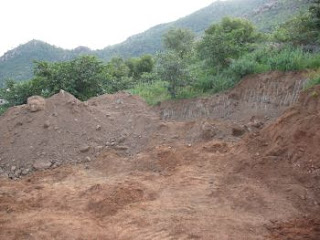In previous posts I mentioned the beautiful Rajarajeshwari Temple, which is located on the Hillround at Parvati Hill about a kilometre before Adi Annamalai Village. In addition to the peculiar facts of the Temple's location, information of which you will find in the Parvati Hill link, the Rajarajeshwari Temple is also unique (at Arunachala) because of the presence of a Sri Meru Yantra in the Temple's Sanctum Sanctorum. One other unique facet of this fascinating Temple is the presence of statue representations of the Dasa Mahavidyas which are worshipped independently and also in conjunction with the Goddess in the Temple's Shrineroom.
The feminine aspect of the Divine represents knowledge (wisdom) and also what is hidden, secret, subtle and sensitive, what has to be searched out and discovered. The Goddess who represents both the teaching and its comprehension, is thus the inner guiding power. She represents creation on all levels, expressed through her Ten Wisdom Forms (Dasa Mahavidyas) and their different functions.
"The Ten Forms of the Goddess function not merely to teach us superficially or intellectually but to challenge us to look deeper. As great cosmic forces their energies can be difficult to bear and their extremes of appearance and expression may jolt us. Their forms are often disturbing, and they are not meant to be merely pleasant. They are meant, like mysteries, to entrance or shock the mind into awakening. They are not meant to merely console or inspire but to promote within us the deepest search. Their forms are ambiguous, contradictory and paradoxical. They are provocative energies designed to take hold of our minds and through their enigmatic nature neutralize the thought process which keeps us in bondage." [by David Frawley]
The Dasa Mahavidyas - The Ten Wisdom Goddesses
 Kali
Kali
Kali: The Goddess of Yogic Transformation. She is thought to be the most mysterious and difficult to understand of the Goddesses. She is dark, destructive, terrible in form, and unpredictable and is allied with the forces of death. She appears alien to ordinary esthetic intepretations of beauty.
 Tara
Tara
Tara: The Saving Word. Tara is not only an important Hindu Goddess, she is also the most important of the Buddhist Goddesses. The word Tara, means the deliverer or saviour and this Goddess is called upon in emergencies or at crossroads where we require guidance.
 Tripurasundari
Tripurasundari
Tripurasundari: The Beauty of Pure Perception. Sundari literally means beauty. To worship this Goddess is to follow the path of beauty and delight through the world of nature into the Absolute.
 Bhuvaneshwari
Bhuvaneshwari
Bhuvaneshwari: The Queen of the Universe. Bhuvaneshwari means the Queen or ruler of the Universe. She is the Divine Mother as the Queen of all the worlds. All the Universe is her body and all beings are ornaments on her infinite being. She carries all the worlds as a flowering of her own Self-nature. She is thus related to Sundari and to Rajarajeshwari, the supreme Lady of the Universe.
 Bala Bhairavi
Bala Bhairavi
Bhairavi: The Warrior Goddess. "Bhairavi specifically means "terrifying" and is the powerful, awesome, or energetic form of the Goddess. She represents transforming heat or radiance, Tejas, which is the primal power or Divine energy. This we experience as a frightening thing because it burns away and destroys all the limitations and illusions of egocentric existence." [David Frawley]
 Chhinnamasta
Chhinnamasta
Chhinnamasta: The Consciousness Beyond the Mind. The name Chhinnamasta, literally means "a severed head" - is the most frightening form of the Goddess. She has cut off her own head and, holding it in her right hand, with it drinks the blood flowing from her own severed neck. Yet her face is not frightening but happy, even blissful. What she presents is the joy of transcending the body, not the pain of losing it. She is also the most energetic form of the Goddess and shows the power of transformation in action.
 Dhumavati
Dhumavati
Dhumavati: The Grandmother Spirit. Dhumavati is the eldest among the Goddesses, the Grandmother Spirit. She stands behind the other Goddesses as their ancestral guide. As the Grandmother Spirit she is the great teacher who bestows the ultimate lessons of birth and death. She is the knowledge that comes through experience.
 Bagalamukhi
Bagalamukhi
Bagalamukhi: The Hypnotic Power of the Goddess. Bagalamukhi is the Goddess of speech, and as such is related to Tara and regarded as a form of her. When sound becomes manifest as light, Tara, becomes Bagala. "When the brilliant light of speech comes forth, then Tara gains the effulgence of Bagala and causes all things to become still. Bagala is thus the stunning radiance that comes forth from the Divine Word and puts the human or egoistic word to rest." [David Frawley]
 Mantangi
Mantangi
Mantangi: The Utterance of the Divine Word. Mata literally means "a thought" or "an opinion". Matangi is thus the Goddess power which has entered into thought or the mind. She is the word as the embodiment of thought. She bestows knowledge, talent and expertise.
 Kamalatmika
Kamalatmika
Kamalatmika: The Lotus Goddess of Delight. Kamalatmika is one whose nature is of the lotus. The lotus Goddess is Lakshmi, the consort of Lord Vishnu, the preserver of the Universe. Kamala is Lakshmi among the Ten Wisom Goddesses (Dasa Mahavidyas) and is the goddess of wealth, beauty, fertility, love and devotion.
*****************
To find out more about the Dasa Mahavidyas please refer to "Tantric Yoga, And the Wisdom Goddesses" by Dr. David Frawley



















































